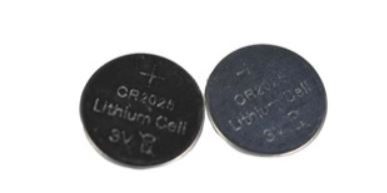an email newsletter released every month highlighting the latest articles, events, technical inquiries, and voices from the community
Battery Technologies for SOCOM Scatterable Loudspeaker Applications

Posted on October 10, 2019 | Completed on October 28, 2019
What battery technologies exist in the 2030 size (coin) to efficiently power a next gen loud speaker-scatterable technology?
1. Inquiry
HDIAC received the following technical inquiry from United States Special Operations Command (USSOCOM):
“What battery technologies exist in the 2030 size (coin) to efficiently power a next gen loud speaker-scatterable technology?”
Additional Information: SOF ATL PEO-C4 (MISO) has a request for an advanced battery survey for a distributed media technology (NGLS-SM, Next Generation Loud Speaker-Scatterable medium). (Think of it as a postcard, made of fiber-board, with imbedded circuitry to play messages and gather biometric info; replaced dropping FM radios with only one channel….) The current battery solution is 4 (qty) 2030 / 2032 coin batteries, (3 V) like used for watches, body sensor monitors, rifle optics, etc. * The cost is <$40 for the entire circuit card and batteries. SOCOM is looking for the most efficient battery that is more efficient than the current 2030 LiO batteries. Can be LiO or exotic (atomic). Might incorporate a stick-on solar panel to extend battery life, so rechargeable is OK also. * The intent is that these get dropped on a target audience and are able to play the message multiple times with a life span of about 7 days. This, of course, is dependent on the batteries, so SOCOM is looking for alternate solutions that would extend the usability. The devices also include a GPS chip and a Long Range (LoRa) Transmitter to collect metadata from the device which also add to the battery consumption. The batteries need to also be low cost, as the scatterable media is meant to be disposable and not recovered.
2. HDIAC Response
A 2030/2032 single cell battery is the shape of a round, flat disc or cylinder, typically 5 to 25 mm (0.197 to 0.984 in) in diameter and 1 to 6 mm (0.039 to 0.236 in) high. They are typically single-cell, disposable batteries. Anodes are commonly made of zinc or lithium, while the most common cathode materials are manganese dioxide, silver oxide, carbon monofluoride, cupric oxide, or oxygen from the air.
Batteries of different chemical composition that are the same size can be used in place of one another; however, the materials chosen will affect service life and voltage stability.
3. Battery Makeup for the SOCOM Loudspeaker Application [1]
General. LiSOCl2 gains the user about 60% more specific energy over LiMnO2 (which is what is used in the 2030 batteries in use by the application currently). Zn-Air can get you about 80%-100% more specific energy over LiMnO2.
LiSOCl2 Batteries. The advantage of the LiSOCl2 battery is that it has almost triple the specific energy of a 2030/2032 button cell. Theoretically, tripling the specific energy should result in a tripling of the operating time (at the same mass) or the operating time for 1/3 the mass. It must be noted that, for batteries, the specific energy is highly dependent upon the discharge rate (how many mA are being drawn). Eagle Picher and Saft sell aerospace/military-grade LiSOCl2 batteries in a variety of sizes; however, there is nothing like the “button cell,” though, currently in use on the SOCOM loudspeaker system; these batteries are larger and heavier (~”D cell” at 90 g).
Zinc-Air Batteries. Zn-Air batteries are readily available for hearing aids, and the P675 size is the largest capacity. They may or may not be suitable for this application, as the life span will depend on the manner in which the device (and hence the battery) is deployed. Since the battery uses air to create the chemical reaction that yields the energy, it must be exposed to air; hence, the operator would need to remove the seal and expose the battery to air before it works. Once the seal is removed, the battery has an approximate shelf-life of 7-10 days, so thought would need to be given with respect to the tactics, techniques, and procedures used when employing this type of battery.
Renata makes a high specific energy 675 Zn-Air battery; however, these are almost twice as thick as a CR2032 (5.4 mm vs. 3.2 mm). Zn-Air is also half the voltage, but it’s exactly half, so the application could employ a series pair and retain the same circuitry (https://www.renatabatteries.us/sites/default/files/2018-01/ZA675%20Renata%20V02.pdf).
| Battery | Chemistry | Charged (V) | Cut-off (V) | Capacity (mAh) | Mass (g) | Specific Energy mW-hr/kg (W-hr/kg) |
|---|---|---|---|---|---|---|
| CR2032 [2] | LiMnO2 | 3 | 2 | 235 | 2.9 | 202.5862069 |
| Eagle Picher LTC-12MC-S7 [3] | LiSOCl2 | 3.5 | 2.5 | 1500 | 14 | 321.4285714 |
| P675 [4] | Zn-Air | 1.4 | 1.05 | 575 | 1.9 | 370.7236842 |
| Saft LS 22600 L [5] | LiSOCl2 | 3.6 | 2.5 | 17000 | 90 | 576.1111111 |
4. References
[1] Keim, N. “RE: Looking for some quick turn help…” Email Message to Stephen Redifer, 25 October 2019.
[2] https://www.mouser.com/datasheet/2/315/3627_fileversion-1627278.pdf
[3] https://www.eaglepicher.com/sites/default/files/LTC-15MC-S7%200119_0.pdf
[4] http://data.energizer.com/pdfs/675.pdf
[5]https://www.saftbatteries.com/download_file/6X7JMGAnv3Fm6HdmtEv%252B2gtlbZ1bRRVHkjS11M6md92GD2EF7vU%252F3Oybbz3WOlG%252BxR8srpA5iCdJ%252FV3IQzTVHQyiTucngZKEg9KkYCLkowAvgaG1huriQtvLPId%252BBXYtLMVYC5k0aZDuuWSgcV7BUpmya8EKflHlvP29ydzeLaLJRiR4TQ%253D%253D/LSP%2B33600-3F_Datasheet-31169-2-0618.pdf
Want to find out more about this topic?
Request a FREE Technical Inquiry!

